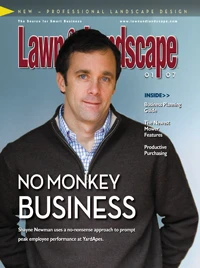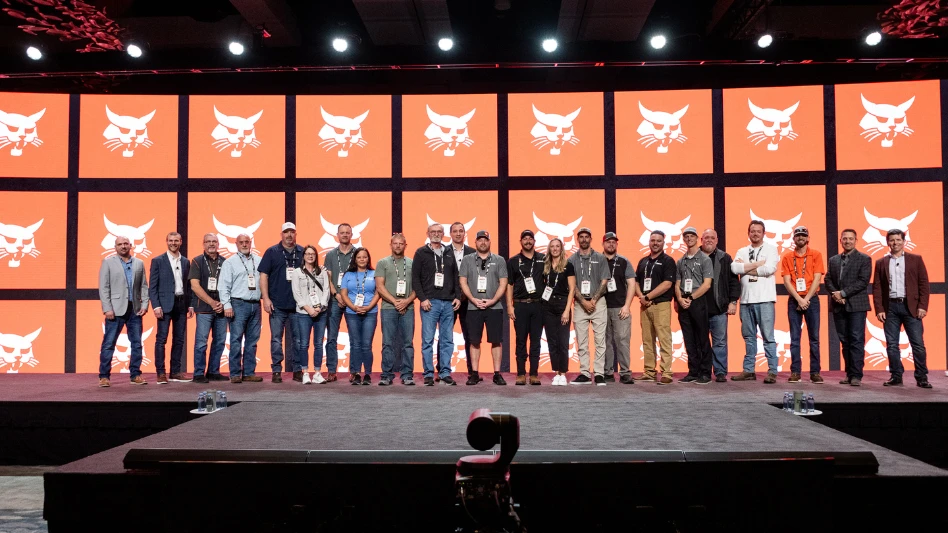Crystal balls. Rolling the bones. Reading tea leaves. Certainly there is a better way to get a handle on contractor spending trends in the coming year?
In fact, the majority of suppliers and manufacturers serving the landscape industry take contractor spending very seriously. Instead of simply rolling the dice, they closely monitor their respective markets, conducting extensive research to gain insight on what the coming year has in store for them and the overall industry.
|
|
With an impotent economy, fluctuating fuel costs, nontraditional weather patterns and a cooling of a once red-hot new-housing market as factors, manufacturers and suppliers initially feared an economic domino effect.
For example, one scenario, many inside the industry anticipated, foretold homeowners, burdened by economic pressures, cutting costs and curbing spending on outdoor convenience services, such as lawn mowing and maintenance, and putting off building projects, such as a new backyard patio or outdoor lighting. This has not necessarily been the case, according to industry insiders.
It’s a trend the industry started to see develop the year before. Reacting to this plausible market scenario, many landscape equipment manufacturers and suppliers tailored back production in 2006. As such, power equipment manufacturers trimmed their shipments of handheld equipment between 4 and 6 percent, according to research conducted by the Alexandria, Va.-based Outdoor Power Equipment Institute. Level reductions were also seen in walk-behind and riding mower production, where manufacturers reduced their shipments by 2 to 3 percent, according to OPEI’s data.
Likewise, many within the industry feared the continued reduction in new-housing starts on a national level would further impact landscape contractors’ overall spending habits.
“With housing slowing down a little bit, lots of landscape contractors are getting nervous about the coming year because they’re no longer seeing significant growth in this area,” says Jonathan Kuyers, landscape segment manager at Pella, Iowa-based Vermeer. “This could have an impact on equipment spending.”
However, projections for 2007 have been rethought and manufacturers and suppliers now feel “cautiously optimistic” about the state of the landscape industry and the mind-set of the North American landscape contractor. Indeed, consumers are proving they will continue to invest in contractor services, such as mowing and chemical lawn care applications. Likewise, the trend towards additional home improvement has not wavered.
“The landscape industry is still growing as a total industry,” says Mark Urbanowski, senior marketing specialist for turf, ornamental and technical products at Dow AgroSciences in Indianapolis. “We look across our portfolio and we anticipate growth.”
And if landscape contractors can continue to sell projects and services into 2007, they will continue to generate the capital and confidence necessary to invest and spend, manufacturers say.
HANDHELD PRODUCTS. In regards to contractor equipment spending, handheld equipment sales trends traditionally differ from those associated with big-ticket items, such as skid-steers and excavators.
Historically, handheld equipment spending flies under the economic radar, says Joe Fahey, vice president of marketing for Echo, headquartered in Lake Zurich, Ill. It’s been a good position because in a soft market contractors continue to purchase commercial-grade handheld equipment, he says.
However, contractor spending patterns over the last year have deviated away from this long-held economic trend, Fahey says.
“Sales in the handheld market were spotty last year,” Fahey says. “The 2006 year was kind of a curious one for handheld equipment sales, and as we look at 2007 we expect similar conditions to what we saw over the last year.”
However, according to recent Lawn & Landscape research, contractors are optimistic about handheld equipment spending in 2007. A third of contractors say they plan to purchase backpack/handheld blowers, and more than 30 percent will purchase trimmers/edgers, according to the research.
Unseasonable weather and a decline in new-housing starts both contributes to this curious nature in contractor spending, Fahey says.
“Weather is just a huge part of this business and it drives a lot of these spending trends,” Fahey says.
For example, a warm winter can have devastating effects on a landscape contractor who supplements his off-season income with snow removal services. A lack of snow and ice events reduces the level of ready cash in this contractor’s pocket as spring approaches and curbs the amount of equipment he’s capable of purchasing for the approaching season.
“If weather conditions are not suitable, it doesn’t matter what the overall economy is like,” Fahey says. “We’re certainly optimistic about 2007 but conditions are soft right now. Spending is off, but not that off.”
MOWERS. For the commercial mower market, so much related to contractor spending depends on overall weather trends that it is challenging to accurately forecast what spending will be like in the coming year.
Wetter-than-normal conditions on the East Coast and drought conditions in the western part of the country all contribute to irregular growth and mowing patterns, manufacturers say, and result in varying contractor spending habits. Even snowfall patterns impact mowing sales.
“No snow will mean contractors won’t have the funds from winter snow removal work available at the start of the landscape season to spend on new equipment, and that’s not good,” says Dan Dorn, product sales manager with Beatrice, Neb.-based Exmark Manufacturing.
Contractor spending on mowers during Fall 2006 was steady, Dorn says, but not spectacular.
“With winter shaping up to be warm and on the dry side, our predictions have gone soft. We remain optimistic, but cautious,” he says.
In reaction to economic and seasonal pressures, landscape contractors have been doing more with the mowers they already own.
“What we’ve been seeing in the industry over the last few years is that contractors are trying to run longer on the equipment that they have,” Dorn says. “They’re extending the replacement interval and they’re stretching an extra two or three years out of their equipment beyond what they can go with them.
“However, we can also interpret this to mean that they’re not in a good position to commit to some spending in finally replacing that equipment,” Dorn says.
More than a quarter (26 percent) of landscape contractors indicate they plan to purchase riding mowers in 2007, and nearly a quarter (23 percent) plan to buy walk-behind mowers in the coming year, according to Lawn & Landscape data.
Another mild January, February and March will prime contractors to attack the landscape season earlier than normal, which includes new equipment purchases. “It’s all weather dependent,” Dorn says.
LANDSCAPE EQUIPMENT. According to Lawn & Landscape research, contractor spending on landscape equipment, both large and compact, may be soft in 2007.
Only about 15 percent of landscape contractors indicated they planned to purchase skid-steers or skid-steer attachments in 2007, and only 11 percent of contractors planned to invest in a mini skid-steer in the coming year.
Likewise, contractors indicated flat spending projections for equipment such as trenchers (7 percent), excavators (6 percent) chippers/grinders (5 percent) and hydroseeders (4 percent).
Vermeer’s Kuyers says they are more optimistic about this market segment because, in an effort to reduce labor costs, contractors are more open to investing in landscape equipment such as mini skid-steers, landscape attachments and trenchers.
“Landscape contractors are looking for more ways to become productive without having to add labor,” Kuyers says. “They’ll be looking at purchasing equipment that will allow them not to replace, but augment, their existing labor.”
Large-equipment sales, however, may become stagnant in 2007, Kuyers says. “While homeowners are not spending as much on big outdoor projects contractors will be taking on smaller jobs,” he says. “With these scaled-down jobs contractors won’t need such big equipment and will continue to generate the need for compact equipment.
Likewise, if contractors become conservative about new equipment purchases, Kuyers predicts the rental market could see a boost.
“Contractors will rent what they need to complete jobs on a project-by-project basis,” he says. “And they’ll also be more apt to rent equipment before making a future purchasing decision.”
SPECIALTY CHEMICALS. Pesticide and fertilizer manufacturers, too, are “cautiously optimistic” about 2007.
While new housing starts may be cooling, Urbanowski says Dow’s research indicates demand still exists for maintenance services in 2007, a definite opportunity for contractors and lawn care operators.
“We see the need for additional maintenance services in 2007, much better than we saw in 2006” Urbanowski says. “Having the homeowner continue to see a need to have this service is a key driver to contractor success in the coming year.”
Reduced new housing starts or a cooling economy shouldn’t dissuade contractor spending on chemical products, says Jim Fetter, director of marketing at Bayer Environmental Science in Columbus, Ohio.
“There has been some talk recently about the market declining,” Fetter says. “But that’s not necessarily bad. When people aren’t selling their homes and moving around, they’re staying home and maintaining their homes a little better.”
Outside economic factors, though, will weigh heavily on contractor spending in this market segment.
“As we look across our portfolio we do anticipate growth, but we also anticipate LCOs will have some difficult decisions to make on what products they’ll be using in 2007,” Urbanowski says. “Will they go with a premium product, or will they go generic to save some money?”
Recent Lawn & Landscape research also reflects this spending outlook. Nearly 60 percent of contractors planned to purchase fertilizer products in the coming year, according to the data. Likewise, between 40 and 50 percent planned to purchase preemergent, postemergent or nonselective herbicides in 2007, according to the research.
More than 30 percent of contractors planned to purchase fungicides and fertilizer/pesticide combination products in the coming year, and nearly 37 percent indicated they planned to purchase insecticides, according to Lawn & Landscape data.
Likewise, more than 20 percent of contractors plan to purchase chemical sprayers and spreaders in the coming year, according to the research.
Over recent years, LCOs have sought to lower their costs, boost profits and remain competitive, perhaps to their own detriment.
“These folks have shaved back their rates to the absolute minimum and got bitten in the end,” Urbanowski says. “Going into 2007 we’re going to see contractors and LCOs re-evaluate what they’re doing in their programs as contractors continue to juggle their costs of doing business.”
Contractors were less enthusiastic about purchasing plant growth regulators and perimeter pest control products (15 percent), as well as chemical tree care products (14 percent), according to the data.
So what may encourage some of this spending?
Last year was a challenging one for fungicides because of lower-than-normal disease rates across most of the country. Urbanowski anticipates a return to a normal disease pattern in 2007, which gives LCOs the opportunity to provide clients with fungicide treatments as an add-on service.
Likewise, the lawn care industry remembers 2006 as having the worst crabgrass in recent history, Urbanowski says. As such, clients haven’t forgot this and will be demanding that their LCOs prevent crabgrass’ repeat performance in 2007.
“You can almost guarantee pre-emergent demand will be up,” he says. “We’re going to see some different dynamics because of last year’s crabgrass problems.”
In addition, Urbanowski says landscape contractors could tap ornamental care as an additional add-on service for 2007.
“If you’re there to treat the lawn you can also be there to treat the client’s ornamentals as well,” he says. “It’s a natural add on.”
SNOW AND ICE REMOVAL. Suppliers and manufacturers serving the snow removal industry are in as much of a quandary about the coming year as their contractor clients.
The bulk of contractor spending on big-ticket items, such as snowplows spreaders and snow removal attachments, takes place between October and the first week of December, manufacturers say.
However, insiders within the chemical industry that manufacture anti-ice and ice-melt products say Winter 2005-06 was a dismal year for their industry. As such, chemical suppliers were left with a lot of unused inventory.
If this snow season ends up as another lackluster winter, suppliers will likely start cutting attractive deals to move this over abundance of product, insiders say.
Going into 2007, the disappointment of the previous year still lingers not only in the minds of North American snow contractors, but also with their clients and prospects, says Isaac Paonessa, regional sales manager at Ledex Industries in Oakville, Ontario, Canada, which manufactures the Avalanche brand snowplow.
Lack of snow for more than one consecutive season causes clients to delay making snow removal decisions or dissuade them from getting locked into long-term deals, Paonessa says.
“The industry – both for contractors and for suppliers – needs for it to snow hard early on in the season,” Paonessa says. “If contractors are then able to sign the contracts they want, they will pay attention to purchasing better-quality equipment.”
And if snow and ice removal services remain flat in 2007, contractors will begin asking themselves the tough questions, says Mark Hall, director of marketing and sales for Warren, Mich.-based TrynEx International, a maker of deicing spreaders.
“Contractors will begin asking themselves if their equipment, which should have been replaced this year and wasn’t, can in fact go one more year,” Hall says.
However, Hall remains positive about contractor spending in the snow removal market.
“The bottom line is, regardless of the weather predictions, there’s going to be snow and there’s going to be ice,” Hall says. “All of this will be good for sales because contractors then will begin spending. Even in a recession, a guy with a pickup will see that there is some snow and ice and will run out and buy a plow and a spreader to make some money.”
Recent Lawn & Landscape research, though, does not reflect Hall’s optimism. According to landscape contractors who push snow and offer ice melting services, less than 15 percent plan to purchase snow plows or salt spreaders in 2007. Nearly a quarter of contractors, roughly 21 percent, plan to purchase anti/deicing products, according to the research.
PRIMING SPENDING. So how can manufacturers stimulate contractor spending in 2007? In the past, sales incentives have captured contractor business, but retooling the sales approach may not be enough. Across market segments, manufacturers recognize that contractors want products that reduce costs and increase efficiencies.
“What can’t the contractor live without,” Kuyers says, playing to the contractor's desire to troubleshoot labor problems and to do more with less. “That’s one way to approach them as customers.”
Bringing new products to market can jump start spending, as well. Contractors committed to spending dollars in 2007 will be looking first at companies with new models in their product lines.
If winter proves to be warm and sales soft, Paonessa says manufacturers and suppliers will be forced to consider incentives to motivate contractor spending, but these may not necessarily be financial lures.
“Poor sales should motivate us to see what types of incentives we can offer contractors,” Paonessa says. “And that may not mean financial incentives, but rather innovations.”
“If you’re just holding your ground, others in this market will drive right past you,” Exmark’s Dorn says. “Those not invested in innovation have nothing to offer the contractor and they’ll lose out.”
“New product offerings can often bring contractors out of their shell and get them to stimulate the marketplace,” Echo’s Fahey says. “Contractors are looking for increased durability and efficiency, not cosmetic changes. For new products to stimulate spending, they have to bring real value to the industry.”
And if contractors believe in a product, they are less likely to switch brands, Paonessa says. “Innovation builds loyalty and comfort levels with contractors,” he says. “Once they have that, they’re less likely to change.”

Explore the January 2007 Issue
Check out more from this issue and find your next story to read.
Latest from Lawn & Landscape
- North by Northwest's charitable act for the Ronald McDonald House Charities
- Coxreels expands V-100 Series product line
- Landscape Workshop expands with 2 acquisitions
- Wilson360 adds Daniel Grange as new consultant
- Batman and business
- CH Products releases new tree stabilizer
- Savannah Bananas founder Jesse Cole to speak at Equip Exposition
- Catch up on last year's Benchmarking report






